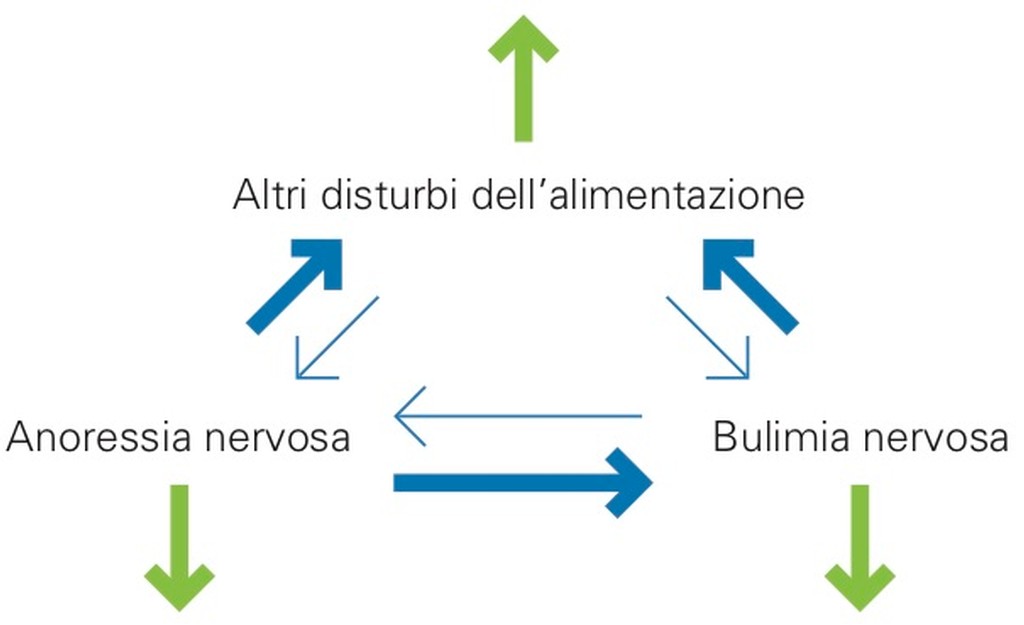Eating disorders are pathologies characterized by an alteration of eating habits and an excessive concern for weight and body shapes. They mainly occur during adolescence and mainly affect the female sex.
The main eating disorders are Anorexia Nervosa, Bulimia Nervosa, and Binge Eating Disorder. The diagnostic manuals also describe other related disorders, such as feeding disorders and subthreshold eating disorders, a category used to describe those patients who, despite having a clinically significant eating disorder, do not meet the criteria for a full diagnosis.
It should be emphasized that obesity has not been included in DSM 5 among eating disorders. In fact, obesity is the result of the continued intake of calories over time and excessive compared to habitual consumption. Genetic, physiological, behavioral and environmental factors contribute to its development, therefore obesity cannot be considered a mental illness, even if, it can be the consequence of it.
Suffering from a eating disorder disrupts a person's life and limits his/her relational, working and social skills. For the person suffering from an eating disorder, everything revolves around food and the fear of gaining weight.
It has been found that many people suffering from eating disorders have a low or depressed mood. In addition, many suffer from anxiety that is often associated with food, nutrition, concerns about weight and body image.
People with eating disorders often suffer from significant physical complications such as blood disorders, gastrointestinal diseases, problems with electrolyte balance, kidney diseases, and cardiovascular diseases that can lead to death. Therefore it is of utmost importance to recognize eating disorders as real and treatable diseases.
Two observations seem to indicate that the medical classification of eating disorders is an artifact and not an accurate description of the clinical reality and that, probably, there is a "only eating disorder" (transdiagnostic hypothesis) that can assume different clinical characteristics from a individual to the other, but also in the same person.
- Eating disorders have similar characteristics (excessive evaluation of the weight and shape of the body that is the tendency to judge one's own value in a predominant or exclusive way in terms of body weight and shape);
- Eating disorders migrate from one diagnosis to another (patients tend to move from one diagnostic category to another but always within eating disorders).
ANOREXIA
The term anorexia derives from the Greek "anorexia" and literally means "lack of appetite".
Anorexia is a disorder characterized by significant weight loss, an intense fear of gaining weight and an altered perception of the evaluation of one's weight and body shape.
People suffering from anorexia are reduced to hunger due to the intense fear of becoming fat. Despite their severe underweight and the emaciated figure they often present, they believe it is never enough. In addition to calories shrinking, they usually try to control weight with extreme physical exercise, compensatory behaviors (vomiting, laxatives or diuretics)
BULIMIA
The word Bulimia comes from the Greek bulimia and literally means ox hunger. This disorder is characterized, in addition to the typical concern for body weight and shape, by recurrent episodes of binging and consequent compensatory behaviors.
Binge eating are episodes in which a person ingests, often without tasting it, large quantities of food, literally losing control.
Following the binge, it is customary to implement compensatory behaviors such as:
- self-induced vomiting;
- use of laxatives, diuretics or other drugs;
- fasting;
- excessive physical activity.
BINGE EATING DISORDER
Binge Eating Disorder or BED is a disorder characterized by the presence of binges but in the absence of compensatory behaviors to control weight.
In this disorder where the person tends to:
- eat much more quickly than normal;
- eat until you feel unpleasantly full;
- eat large amounts of food even if you are not hungry;
- eat alone because of the embarrassment you are eating;
- feeling guilty about the binge.
Compared to other patients with eating disorders, subjects with a binge eating disorder have on average more weight, a higher frequency of overweight or obesity, a more varied age of onset (which can occur at any age, while for anorexia nervosa and bulimia nervosa occur mainly in adolescence), a greater prevalence also in male population.
The most effective therapy for eating disorders is Cognitive Behavioral Therapy, in particular the intervention protocol devised by Fairburn and Dalle Grave (CBT-E).
Furthermore, through Mindful Eating interventions we can learn to observe and regain contact with our senses to regain control to begin to consciously choose, prepare and consume what we eat.
This can be done:
- learning to choose and cook healthy and nutritious foods;
- entering into harmony with the colors, smells, tastes, sounds, temperature and consistency of the food;
- eating slowly, listening to body signals that tell us when to stop eating;
- focusing all our attention on food, minimizing external distractions.


